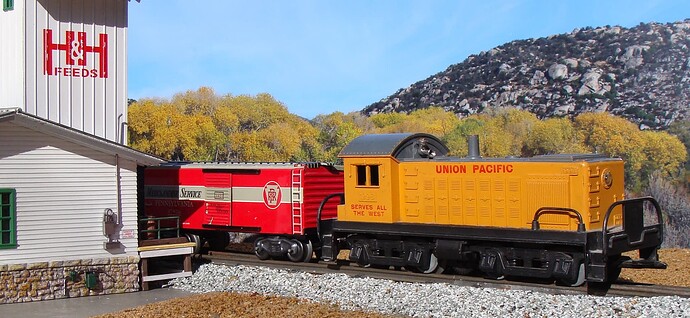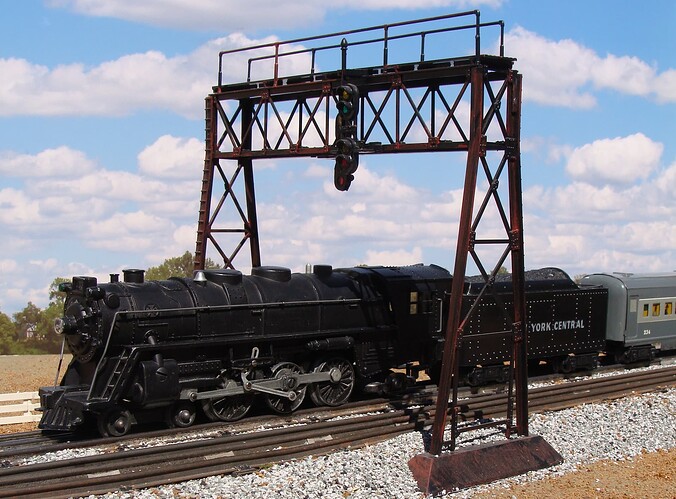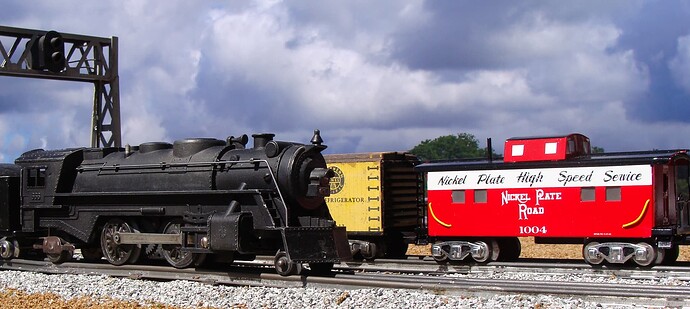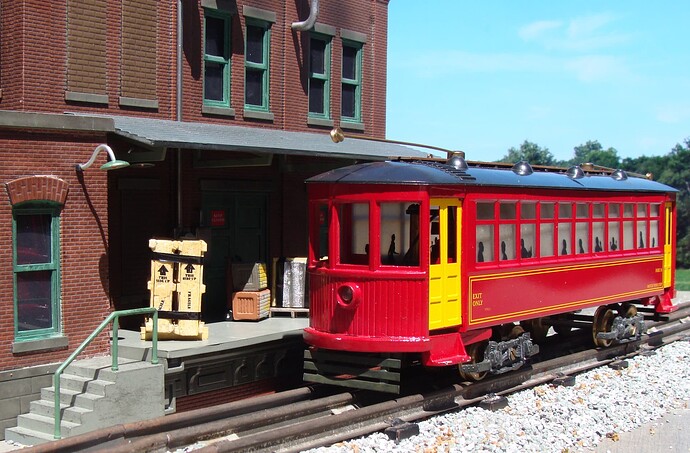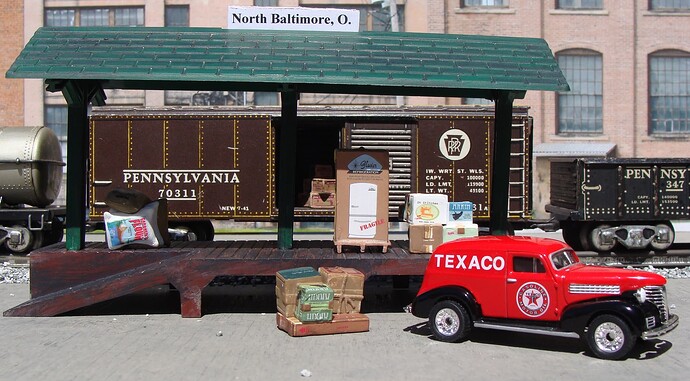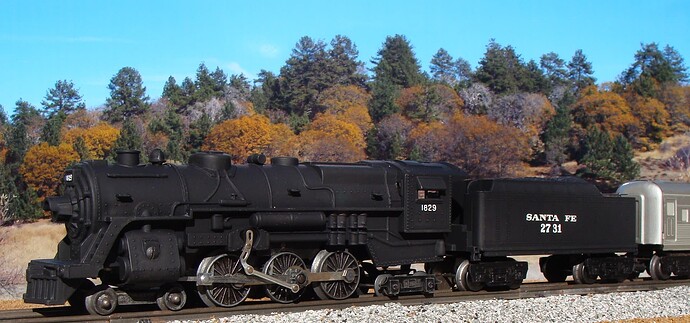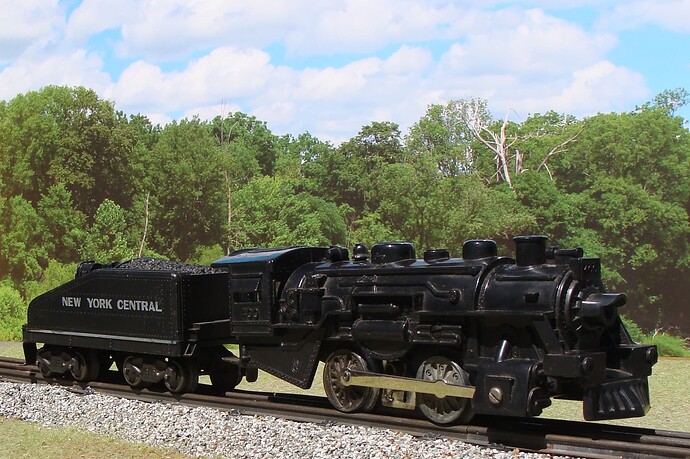I sold my NYC after acquiring it, because it seemed too big for my O27 layout. It ran okay but just looked too big for me, so I thought I would let someone else enjoy it.
Me, too!
It’s one of those locos that I’ve always wanted but never have been able to get.
Plus, if I could get one I could recreate the scene at the end of Back to the Future III!
A 333 NYC passenger train and a Plasticville Signal Bridge. (IMHO, the signal bridge is rather neat looking.)
I had one as a child and it didn’t fair well as a plaything. They are good looking though, I agree
I’ve always liked the signal bridge too! I elevated my black one with foam core “footers” so my #8 Standard Gauge loco will clear with it’s pantograph fully extended. I also have a silver one that I modified into a single track cantilever type.
I didn’t realize some were made in silver.
In the 1990’s Bachmann started production of some Plasticville kits again. Unfortunately, they have not used some of the brighter colors of plastics that they used originally. The 2 story house for example has only been available in shades of forest green and tan ![]() not red and white as before. The new signal bridges were only available in silver either in kit or “built-up”.
not red and white as before. The new signal bridges were only available in silver either in kit or “built-up”.
I use a Marx 666 locomotive with my Nickel Plate set of 3/16th scale cars and the proportion is just about right.
This Brill trolley was NOT made by Marx but by Bowser. (I thought I would drop in a non-Marx item just for variety.)
Bowser trolleys have a reputation for being very reliable and, with regular lubrication, able to run almost forever. In addition to being easy to modify, they run well on 027 track and curves.
Although Bowser no longer lists O-gauge trolleys in their catalog, used ones can be acquired at train shows and through on-line auctions.
I have the original version made by Pittman. Mine is the more ‘de-luxe’ type with operating poles, pole reverse, and scribed sides. Afaik, Bowser never reissued the brill trolley with scribed siding. It’s a nice, smooth runner in both directions. Mine is set up for 3-rail tinplate operation, but Pittman offered a variety of different configurations in both kit and RTR form. Minitoys also sold a 3-rail RTR version of the Pittman brill trolley which most closely resembles the Bowser in terms of features. The Minitoys versions had a Thomas Industries center rail pickup, whereas Pittman and Bowser versions use rollers.
-El
That they are and that they do! I’ve got two Bowser trolleys, Virginia Train Collectors club cars issued in 1988 and 1989. The only mods I’ve done (Once I figured out how to get the roof off!) were to install interior lights, as delivered they only had head and tail lights.
Too bad they’re not made anymore, they’re darn near bulletproof!
Few collectors today realize that this trolley’s linage goes back to the late 1940s and the Pittman Electric Development Company.
Charles A. ‘Al’ Pittman, Jr. established his company in 1935 to develop new products for the model railroad industry. (The Pittman motto was, “Large Scale Realism in Small Space.”) Pittman soon became synonymous with quality model railroading motors which it supplied to manufacturers such as Classic Model Trains, General Models Corporation, Revell, and Atlas. Pittman eventually became the world’s largest manufacturer of electric motors for scale model trains.
As a sideline to its motors, in the early 1940s Pittman began offering realistically detailed HO scale electric trolleys.
In the late 1940s, Al Pittman began to offer ‘O’ gauge freight and passenger trolleys in kit form. The first of these was based on a passenger trolley made by the J. G. Brill Company of Philadelphia, once the largest manufacturer of streetcars and interurban cars in the United States.
The Pittman trolley kits consisted of unpainted metal castings and brass parts, with the power truck sold in a separate kit. These trolleys could operate on either overhead or third rail power.
For those who lacked the necessary modeling skills to build a trolley from a kit, ready-to-run Pittman ‘O’ gauge trolleys were available from Minitoys, Inc., which sold them via mail order and through its Hobbyland store located in Manhattan.
After Al Pittman died in the early 1960s, the Pittman trolley kits, which had been Al’s special interest, went out of production.
At about the same time that Al Pittman was getting ready to release his first ‘O’ gauge trolley kits, Bill Sheldon Bowser was launching his Bowser model railroad business. (The ads for Bowser’s first steam locomotive began appearing in model train magazines in 1948.) In 1961, the Bowser Company was purchased by Lewis and Shirlee English who moved it from its original location in Redlands, CA to their basement in Muncy, PA, where they operated it as a parttime business. In 1965, Bowser moved to Montoursville, PA, where it became a full-time operation.
For years, Bowser had obtained its electric motors from the Pittman Company. Around 1980, Pittman advised Bowser that it would soon stop producing hobby motors. To be sure of having a continuing supply of motors for its products, Bowser acquired the tooling for Pittman’s powerful DC-71 motor. Included in this deal was the tooling for Pittman’s ‘O’ gauge Brill trolley.
By the first half of 1981, Bowser had a ready-to-run ‘O’ gauge Brill trolley on the market. This trolley had an all-metal body, a plastic roof, a 3-position E unit, interior lighting, and operating headlights on both ends. The earliest version of the Bowser trolley came with an open frame motor and brass gears. A later version had a DC permanent magnet motor and plastic gears. The two brass trolley poles located fore and aft on the roof were there just for show. Sold in the paint schemes once used by actual streetcar systems, it was available in single and double truck versions for either 2-rail or 3-rail operation.
Given the Bowser Brill trolley’s relatively high price - over $304 in today’s dollars - and the limited market for ‘O’ gauge trolleys, it is probably safe to assume that its sales numbers were not as high as those for Bowser’s HO scale trolleys. By 2011, reports surfaced that Bowser wanted to sell the tooling for its ‘O’ gauge Brill trolley.
A .pdf file with the instruction sheet and parts list for the Bowser Brill trolley can be found on-line.
Mine seem to be noisy despite lubrication. Is that normal for these?
I have one Birney and one Brill.
Both 3-rail O gauge with no reverse.
I’ve got the Bowser two-trucked models (Brills I assume?) and I don’t consider them any more noisy than any other three-rail O Gauge trains. Then again O Gauge is kind of noisy to begin with so maybe I’m just used to it.
Being made of sheet metal always seems to add to the noise factor as well.
Mine are packed away right now. I’ll have to get them out again soon and take another look.
Marx’s 1829 4-6-4 Plastic Locomotive. (Louis Marx wasn’t a big fan of toy locomotives with leading and trailing trucks as they often caused derailments.)
In the mid-1950s, when Marx was producing 300,000 toy train sets a year, most of these sets had a 400-series locomotive like this No. 400 locomotive. (Louis Marx probably loved these 400 series locomotives since they had no leading or trailing trucks to drive up production costs and cause derailments.)
